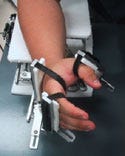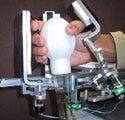Robots Have a Hand in Helping Stroke Patients
May 1, 2007
R&D DIGEST
|
The robot helps the brain relearn movement, says Cramer. |
Patients recovering from stroke often experience difficulty grasping and releasing objects. But a recent study says that a robot-led therapy could help them recover strength and normal use of their hands.
The therapy makes use of a Hand-Wrist Assisting Robotic Device, known as HOWARD, developed at the University of California, Irvine (UCI). The device wraps around the hand and is run by a computer program that directs patients through a physical therapy program. Users initiate the hand motions, and the robot monitors and assists movement to meet therapeutic goals.
Steven Cramer, PhD, is senior author of the study and an associate professor in neurology, anatomy, and neurobiology at UCI. He explains that the therapy isn't passive. “The patient has to jump-start the program and initiate the motor command,” he says. “But if the hand is weak and can only budge one-tenth of an inch, the robot helps to complete the task so the brain relearns what it's like to make the full movement.”
The study reports that stroke patients with impaired hand use had improved ability to grasp and release objects after 15 therapy sessions with HOWARD.
The study included seven women and six men who had suffered a stroke at least 3 months before beginning the pilot therapy. All patients had at least moderate residual weakness and reduced function of the right hand. Cramer notes, however, that none of the patients were totally paralyzed or unable to feel.
Cramer explains that under normal circumstances, spontaneous functional improvement occurs in the first 3 months after a stroke, but that the improvements plateau quickly. Therapy is often needed to continue rehabilitation. “Robot-assisted therapy may help rewire the brain and make weak limbs move better long afterwards,” he says.
|
|
Only partial help is given so that patients can fully complete the tasks. |
The patients were 63 years old on average. They received 15 two-hour therapy sessions over a period of 3 weeks. All worked with HOWARD during the 15 sessions. For seven patients, the therapy shaped and helped complete movements across all sessions. For six of the patients, the HOWARD provided complete support for the second half of the sessions and partial support for the first half.
After 3 weeks, all patients reported improvements in their ability to grasp and release objects. Their average score on an Action Research arm test—which measures the ability to perform such real-world tasks as grasping a block and gripping a drinking glass—improved by nearly 10%. The average score rose by nearly 20% on the box-and-blocks test, which assesses manual dexterity as one moves blocks from one side of a box to another in 1 minute. The patients also developed a 17% greater range of motion in their hands and wrists and were rated as less disabled on a standard occupational therapy assessment tool called the Fugl-Meyer score.
This stroke study is one of the first to use robotics to improve hand function. Previously, robotic devices had only been used for poststroke shoulder and leg functions.
Using the results from the study, Cramer is now beginning to create a second-generation device that improves on the hand-robot connection. It will also include more software options to better respond to individual needs and to keep patients interested and encourage their compliance in the rehabilitation program.
The HOWARD study findings were presented in February at the American Stroke Association's International Stroke Conference in San Francisco. The study was partially funded by a National Institutes of Health Institutional Training Grant.
Copyright ©2007 Medical Device & Diagnostic Industry
About the Author(s)
You May Also Like



.png?width=300&auto=webp&quality=80&disable=upscale)

